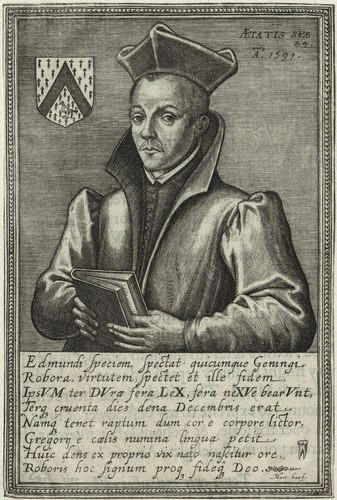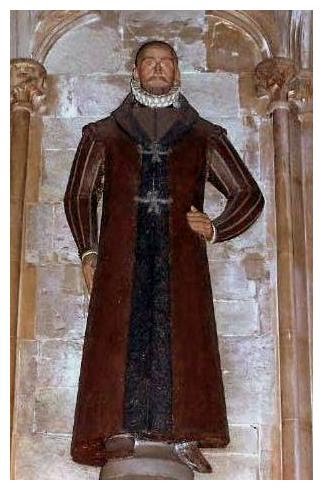Swithun Wells was born at Brambridge, Hampshire, England around 1536; the youngest of five sons, his parents were Thomas Wells (or Welles) and Mary, daughter of John Mompesson.
He was christened with the name of the ninth century local saint and Bishop of Winchester, Swithun. They were a determinedly Catholic family who, during the Reformation, were to assist in the clandestine burials of Catholics in the local churchyard and whose house became a refuge for priests. His eldest brother, Gilbert, died a known recusant having forfeited the property, but it was later restored to the family by Charles II.
We know that for six years he kept a school for young gentlemen at Monkton Farleigh in Wiltshire and that for many years he conformed to the state requirement to attend Protestant services. In 1583, Swithun Wells was reconciled to the Catholic Church.
In 1585 he went to London, where he took a house in Gray’s Inn Lane. November 7, 1591, Fr. Edmund Gennings (b. 1567) was saying Mass at Wells’s house, when the priest-hunter Richard Topcliffe burst in with his officers. They would all be executed outside that same house.
Gennings, from Lichfield, Staffordshire, was a thoughtful, serious boy naturally inclined to matters of faith. At around sixteen years of age he converted to Catholicism. He went immediately to the English College at Reims where he was ordained a priest in 1590. He soon returned to England under the assumed name of Ironmonger. His missionary career was brief.
Topcliffe, “the Queen’s Torturer”, “the cruelest tyrant in all of England”, was a lawyer in the employ of the Privy Council and a sadistic interrogator and torturer and a sexual sadist – a man, it is reported, who too much enjoyed his work.
Topcliffe claimed that his own instruments and methods were better than the official ones, and was authorized to create a torture chamber in his home in London. The “Topcliffe Rack”, where the victim is suspended vertically, rather than horizontally, from a wall by manacles far above their height and weights are added to the ankles, was his invention.
The congregation at Wells’ house, now surrounded, not wishing the Mass to be interrupted, held the door and beat back the officers until the Mass was finished, after which they all surrendered quietly.
Wells was not present at the time, but his wife was, and was arrested along with Gennings, another priest, Fr. Polydore Plasden, and three laymen, John Mason, Sidney Hodgson, and Brian Lacey.
On his return, Wells was immediately arrested and imprisoned. At his trial, he said that he had not been present at the Mass, but wished he had been, upon which saying he was sentenced to be hanged, and was executed outside his own house on 10 December 1591, just after Edmund Gennings.
The victim the executioners most wanted to suffer most would be killed last, watching loved ones and friends die brutally before their own passion. Fr. Gennings, a convert to Catholicism at age 17, was killed first. He was 24 yrs old. He is reported to have said, “Sancte Gregori, ora pro me!” while he was being disembowelled, after being hung, but not to death, only stunning him, and that the hangman swore, “Zounds! See, his heart is in my hand, and yet Gregory is in his mouth. O egregious Papist!” The martyrdom of Edmund Gennings was the occasion of several extraordinary incidents, chief of which was the conversion of his younger brother, John, to the Catholic faith, and who became a Franciscan, and who later wrote his biography, published in 1614 at Saint-Omer.
Fr. Polydore Plasden, age 28, at his execution he acknowledged Elizabeth as his lawful queen, whom he would defend to the best of his power against all her enemies, and he prayed for her and the whole realm, but said that he would rather forfeit a thousand lives than deny or fight against Catholicism. In contrast to the others, Sir Walter Raleigh fought for his reprieve, but only succeeded in his being allowed to hang till he was dead, and the sentence was carried out upon his corpse.
It was upon Fr. Plasden’s word that the Mass they attended and for which they were about to die was allowed to conclude peacefully. Due to Fr. Plasden’s concern for the Blessed Sacrament and his fear that the Eucharist might be subjected to sacrilege, he gave his word that he, Fr. Edmund Gennings and those recusants hearing Mass would freely surrender should Mass be permitted to conclude. The infamous Richard Topcliffe knew that Fr. Polydore would keep his word and agreed so as to be able to take them away quietly. The message here is clear. The Mass is the priority. Once concluded, do with us what you wish.
On the scaffold, Swithun Wells, said to Topcliffe, “Hurry up, please, Mr. Topcliffe. Are you not ashamed to make a poor old man stand in his shirt in the cold? God pardon you and make you of a Saul into a Paul, of a bloody persecutor into one of the Catholic Church’s children. By your malice I am thus to be executed, but you have done me the greatest benefit that ever I could have had. I heartily forgive you.” ” His wife, Alice, was reprieved, and died in prison some 10 years later.
-St Edmund Gennings, priest & martyr
-St Swithun Wells, layman & martyr
“If to return to England a priest or to say Mass be popish treason, I here confess that I am a traitor; but I think not so and therefore acknowledge myself guilty of this those, not with repentance but with an open protestation of inward joy!” – St Edmund Gennings, priest & martyr, executed age 24.
Eternal and loving God, the lives of your servants, Swithun Wells and his companions, offer us an example of faithful service to the Gospel and love for the Mass.
Their deaths remind us of the cost that many people pay for witnessing to the Truth.
Through the prayers of St Swithun Wells and his companions
may we be proud of the faith we have inherited from the saints and martyrs, and through our work, prayers, and most importantly Your grace, deepen the roots of the Catholic faith in ourselves and in those who observe our lives.
We ask this through Jesus Christ, your Son.
Amen.
Love,
Matthew


